Kirby Larson's Blog, page 6
December 10, 2014
Wednesday Wisdom
Nothing great was ever achieved without enthusiasm.
Ralph Waldo Emerson
Ralph Waldo Emerson
Published on December 10, 2014 05:30
December 9, 2014
Teacher Tuesday
Teacher Tuesday goes international for the first time with Tanja Galetti’s answers to my little quiz. Tanja is the Primary School Teacher Librarian at Hong Kong Academy, an IB World School in Hong Kong. You can find her on Twitter, on Facebook, on Goodreads and at her library blog.
Tanja, please fill in the blank:
You should never read and (blank) at the same time.
This is a tricky one because I can and enjoy reading in so many different ways (traditional paper books, e-books, audiobooks…) and situations: I love reading while eating, drinking, bathing (never with library books though ;), listening to music, sitting in the park, cooking, working out, going for a walk, commuting to work, shelving books in my library… So is there really a situation when not to read? Hmmm… Maybe, You should never read and swim – because I can really not imagine how that would work without destroying the book, no matter its format. But anything else goes.
If you were invited to be on Oprah, what book would you bring for her to read?
An easy question to answer: I would bring William Joyce’s The Fantastic Flying Books of Mr. Morris Lessmore.
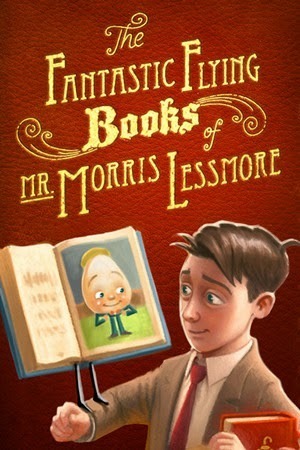
I love many books but treasure this story in a very special way. It is so much about what I believe in as a librarian, a reader, and a writer: “Morris Lessmore loved words. He loved stories. He loved book.”
Just like for Morris, I find that every library is a “mysterious and inviting room” and when I enter I can hear “the faint chatter of a thousand different stories, as if each book was whispering an invitation to adventure”. The Fantastic Flying Books is about who I am and why I treasure books and stories so much. It touches me deeply each time I read it – and I read it often either in its traditional picture book format or the interactive version on my iPad. I know it will move Oprah to tears too because she, just like Morris and all of us librarians believe, that “everyone’s story matters” – and we work towards making sure that everyone’s story is heard – or read.
What is the funniest book you’ve read?
There are so many funny picture books I adore as for example Jon Scieszka’s The True Story of the Three Little Pigs, Leah Wilcox’s Waking Beauty, and of course, each of the wonderful Piggie and Elephant books by Mo Willems. But I would most probably mention an adult book here, a book that I have read and re-read many times, but never read in public! It is the one book that makes me laugh out loud and uncontrollably even though now I already know what comes next: Bill Bryson’s Down Under. I received this book from a very dear Australian friend (thanks, Sharon!) many years ago and turn to it whenever I need some cheering up.
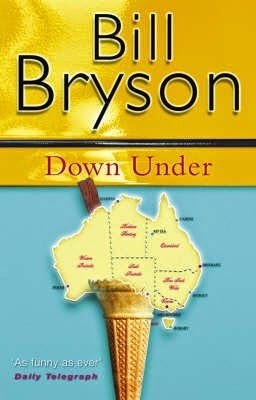

What is the saddest?I cry easily – when listening to someone share a story, when watching a movie and when reading. I don’t think I have ever read a book by Michael Morpurgo book that has not made me cry at some point or another. So I knew right away that for thinking about the saddest book, I had to go through the books I had read by him. Now don’t misunderstand me here, I love and treasure his books since he is such a master storyteller. His stories are just so touching and thought provoking. The saddest I have ever read, and just thinking about it now makes me sad, is The Dancing Bear. A short little volume but a story that once you have read it will never let you go again.
Favorite reading snack/beverage?
Chocolate! Especially when I am reading a sad, emotionally challenging book, I need the comforting feel and taste of chocolate as it melts on my tongue.
What’s next on your TBR list?
I have an ever-growing list of books I want to read as I keep suggestions and recommendations from family, friends and students in my reader’s notebook and on Evernote. This list includes children’s, young adult, adult and professional literature. So let me just pick one from each category that I think I might read next: Children’s literature: Duke (Kirby Larson) – I loved Kirby’s Hattie books and wanted to read this book, which seems very different, for a very long time and now finally have a copy of the book.Young Adult: The Geography of You and Me (Jennifer E. Smith) – After seeing the reviews on School Library Journal and Booklist, I knew I needed to read this books soon. I appreciate a classic love story and relationships over a distance seems to be the story of my life: “(…) it’s a classic dish served up with style, heart, and a long-distance yearning immediately recognizable to anyone who has had to love from afar.”Adult: Edge of Eternity (Ken Follett) – the third and final book in the Century Trilogy, which I have been waiting for since last year. Reading the other two books made me feel I had never really understood much of what happened before, during and after the World Wars while learning about it in my history classes in school. The books made me read additional information on real historic figures and events mentioned in the book. An amazing journey into the past which I can’t wait to continue with the last book which will take me into the cold war era (okay, I have to confess, it’s no more on my TBR list as I just started to read the book…).
Professional: Guy Write: What Every Guy Writer Needs to Know (Ralph Fletcher). Ralph Fletcher is often mentioned in the context of teaching writing through mentor texts, something the school I work at is more and more incorporating. So I have started to look at some of the books the author has written (I loved his childhood memoir Marshfield Dreams!) and this title is next on my list.
Tanja, please fill in the blank:
You should never read and (blank) at the same time.
This is a tricky one because I can and enjoy reading in so many different ways (traditional paper books, e-books, audiobooks…) and situations: I love reading while eating, drinking, bathing (never with library books though ;), listening to music, sitting in the park, cooking, working out, going for a walk, commuting to work, shelving books in my library… So is there really a situation when not to read? Hmmm… Maybe, You should never read and swim – because I can really not imagine how that would work without destroying the book, no matter its format. But anything else goes.
If you were invited to be on Oprah, what book would you bring for her to read?
An easy question to answer: I would bring William Joyce’s The Fantastic Flying Books of Mr. Morris Lessmore.

I love many books but treasure this story in a very special way. It is so much about what I believe in as a librarian, a reader, and a writer: “Morris Lessmore loved words. He loved stories. He loved book.”
Just like for Morris, I find that every library is a “mysterious and inviting room” and when I enter I can hear “the faint chatter of a thousand different stories, as if each book was whispering an invitation to adventure”. The Fantastic Flying Books is about who I am and why I treasure books and stories so much. It touches me deeply each time I read it – and I read it often either in its traditional picture book format or the interactive version on my iPad. I know it will move Oprah to tears too because she, just like Morris and all of us librarians believe, that “everyone’s story matters” – and we work towards making sure that everyone’s story is heard – or read.
What is the funniest book you’ve read?
There are so many funny picture books I adore as for example Jon Scieszka’s The True Story of the Three Little Pigs, Leah Wilcox’s Waking Beauty, and of course, each of the wonderful Piggie and Elephant books by Mo Willems. But I would most probably mention an adult book here, a book that I have read and re-read many times, but never read in public! It is the one book that makes me laugh out loud and uncontrollably even though now I already know what comes next: Bill Bryson’s Down Under. I received this book from a very dear Australian friend (thanks, Sharon!) many years ago and turn to it whenever I need some cheering up.


What is the saddest?I cry easily – when listening to someone share a story, when watching a movie and when reading. I don’t think I have ever read a book by Michael Morpurgo book that has not made me cry at some point or another. So I knew right away that for thinking about the saddest book, I had to go through the books I had read by him. Now don’t misunderstand me here, I love and treasure his books since he is such a master storyteller. His stories are just so touching and thought provoking. The saddest I have ever read, and just thinking about it now makes me sad, is The Dancing Bear. A short little volume but a story that once you have read it will never let you go again.
Favorite reading snack/beverage?
Chocolate! Especially when I am reading a sad, emotionally challenging book, I need the comforting feel and taste of chocolate as it melts on my tongue.
What’s next on your TBR list?
I have an ever-growing list of books I want to read as I keep suggestions and recommendations from family, friends and students in my reader’s notebook and on Evernote. This list includes children’s, young adult, adult and professional literature. So let me just pick one from each category that I think I might read next: Children’s literature: Duke (Kirby Larson) – I loved Kirby’s Hattie books and wanted to read this book, which seems very different, for a very long time and now finally have a copy of the book.Young Adult: The Geography of You and Me (Jennifer E. Smith) – After seeing the reviews on School Library Journal and Booklist, I knew I needed to read this books soon. I appreciate a classic love story and relationships over a distance seems to be the story of my life: “(…) it’s a classic dish served up with style, heart, and a long-distance yearning immediately recognizable to anyone who has had to love from afar.”Adult: Edge of Eternity (Ken Follett) – the third and final book in the Century Trilogy, which I have been waiting for since last year. Reading the other two books made me feel I had never really understood much of what happened before, during and after the World Wars while learning about it in my history classes in school. The books made me read additional information on real historic figures and events mentioned in the book. An amazing journey into the past which I can’t wait to continue with the last book which will take me into the cold war era (okay, I have to confess, it’s no more on my TBR list as I just started to read the book…).
Professional: Guy Write: What Every Guy Writer Needs to Know (Ralph Fletcher). Ralph Fletcher is often mentioned in the context of teaching writing through mentor texts, something the school I work at is more and more incorporating. So I have started to look at some of the books the author has written (I loved his childhood memoir Marshfield Dreams!) and this title is next on my list.
Published on December 09, 2014 05:30
December 5, 2014
Friend Friday
Oh, what a special friend I'm able to introduce today! Tom Brenner shares a bit about how we met in his post, below. What I remember is hearing an incredibly lovely and poetic manuscript read aloud during the Great Critique and wondering if I just might know an editor who would love it as much as I did. I've been a successful matchmaker between writers and agents before but this was my first writer-editor "marriage." Too much fun!
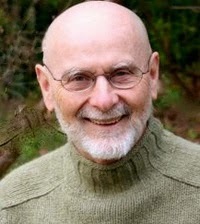 Tom Brenner
Tom Brenner
I give Kirby credit for being able to staple the word “published” to the third of my life’s named career gigs—children’s book writer. Thank you, Kirby. I’m honored to be here. Tom's latest book -- the perfect Christmas gift!The first named career gig, advertising copywriter, came about because a college friend who graduated a year before I did said he was having fun writing jingles in Baltimore. Another big push came because the girl I fell in love with and married was a copywriter at Macy’s, and her father was a high-level ad exec in Detroit. So I became a copywriter. It was easier back in the 60’s to do that. I’m not sure if I it was to impress my wife, or impress my father-in-law, or write a jingle.
Tom's latest book -- the perfect Christmas gift!The first named career gig, advertising copywriter, came about because a college friend who graduated a year before I did said he was having fun writing jingles in Baltimore. Another big push came because the girl I fell in love with and married was a copywriter at Macy’s, and her father was a high-level ad exec in Detroit. So I became a copywriter. It was easier back in the 60’s to do that. I’m not sure if I it was to impress my wife, or impress my father-in-law, or write a jingle.
At any rate, my second named career gig, elementary school teacher, came ten years later when I realized that survival in advertising meant I had to get serious. Just having fun working with an art director wouldn’t cut it. I never wrote a jingle.
I thought about teaching, so I’d have the summers to figure out my working life. I heard that men were scarce and wanted at the elementary level. Aaah! To be wanted. I had a family. I needed a job. I quit. I got a credential and a job teaching sixth grade. And I loved it!
When I retired 26 years later, my plan was to write novels for sixth, seventh graders. I wrote plenty of pages, pounding with glee at the keyboard, laughing and talking to the computer screen. When I got to 200 pages, more or less, I called it a novel. No one else called it a novel.
After we moved to Vashon, I went back to school to learn how to write that novel--the Writing for Children class at UW Extension. An early homework assignment was to write a picture book. Like some of my sixth graders, I didn’t know what to write. I knew ‘dog ate my homework wouldn’t work.’ And I thought: just don’t show up.
The night before the assignment was due, I woke up thinking about Halloween, and the line, “When nighttime creeps closer to suppertime,” popped into my head. I wrote enough to complete the assignment, and revised it based on teacher comments, then took it to the Great Critique. Kirby, who was the leader of the group, was wonderful. Her suggestions, her encouragement, her help directed me on the path to Candlewick.
They bought the book 11 months later--officially starting my third named career gig—published children’s book writer. Three books now: AND THEN COMES HALLOWEEN, AND THEN COMES CHRISTMAS (just out)--AND THEN COMES SUMMER, out in 2017.
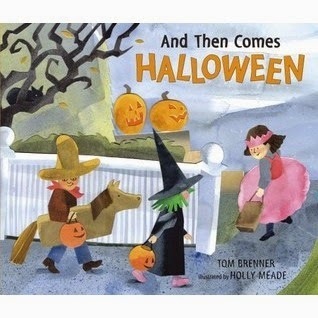
I’m still working on the novel.
Tom and Nancy live in a small house on Vashon with two dogs, two cats, several garden beds, and twenty fruit trees—more than they can handle!
 Tom Brenner
Tom Brenner
I give Kirby credit for being able to staple the word “published” to the third of my life’s named career gigs—children’s book writer. Thank you, Kirby. I’m honored to be here.
 Tom's latest book -- the perfect Christmas gift!The first named career gig, advertising copywriter, came about because a college friend who graduated a year before I did said he was having fun writing jingles in Baltimore. Another big push came because the girl I fell in love with and married was a copywriter at Macy’s, and her father was a high-level ad exec in Detroit. So I became a copywriter. It was easier back in the 60’s to do that. I’m not sure if I it was to impress my wife, or impress my father-in-law, or write a jingle.
Tom's latest book -- the perfect Christmas gift!The first named career gig, advertising copywriter, came about because a college friend who graduated a year before I did said he was having fun writing jingles in Baltimore. Another big push came because the girl I fell in love with and married was a copywriter at Macy’s, and her father was a high-level ad exec in Detroit. So I became a copywriter. It was easier back in the 60’s to do that. I’m not sure if I it was to impress my wife, or impress my father-in-law, or write a jingle. At any rate, my second named career gig, elementary school teacher, came ten years later when I realized that survival in advertising meant I had to get serious. Just having fun working with an art director wouldn’t cut it. I never wrote a jingle.
I thought about teaching, so I’d have the summers to figure out my working life. I heard that men were scarce and wanted at the elementary level. Aaah! To be wanted. I had a family. I needed a job. I quit. I got a credential and a job teaching sixth grade. And I loved it!
When I retired 26 years later, my plan was to write novels for sixth, seventh graders. I wrote plenty of pages, pounding with glee at the keyboard, laughing and talking to the computer screen. When I got to 200 pages, more or less, I called it a novel. No one else called it a novel.
After we moved to Vashon, I went back to school to learn how to write that novel--the Writing for Children class at UW Extension. An early homework assignment was to write a picture book. Like some of my sixth graders, I didn’t know what to write. I knew ‘dog ate my homework wouldn’t work.’ And I thought: just don’t show up.
The night before the assignment was due, I woke up thinking about Halloween, and the line, “When nighttime creeps closer to suppertime,” popped into my head. I wrote enough to complete the assignment, and revised it based on teacher comments, then took it to the Great Critique. Kirby, who was the leader of the group, was wonderful. Her suggestions, her encouragement, her help directed me on the path to Candlewick.
They bought the book 11 months later--officially starting my third named career gig—published children’s book writer. Three books now: AND THEN COMES HALLOWEEN, AND THEN COMES CHRISTMAS (just out)--AND THEN COMES SUMMER, out in 2017.

I’m still working on the novel.
Tom and Nancy live in a small house on Vashon with two dogs, two cats, several garden beds, and twenty fruit trees—more than they can handle!
Published on December 05, 2014 05:30
December 3, 2014
Wednesday Wisdom
Dwelling on the negative simply contributes to its power.
Shirley Maclaine
Shirley Maclaine
Published on December 03, 2014 05:30
December 2, 2014
Teacher Tuesday
I love, love, love that today's guest on Teacher Tuesday is here because she was invited by a colleague -- that's exactly what I'm hoping will happen! So if you work in the schools -- any job from librarian, to teacher to principal to secretary to custodian; any job!-- and you yourself are too shy to play the Teacher Tuesday quiz, it would be wonderful if you would encourage a friend to try. I'd love to run this weekly and am going to need more people like Carrie Strine, who was sent the quiz by her friend, Eve Eaton (seven degrees of Kevin Bacon and all that).
Carrie teaches grade 4 at Sidwell Friends School in Bethesda, Maryland (class twitter here) and is obsessed with traveling and reading – two hobbies that go hand in hand!
Carrie! Thank you for being such a good sport. Now, how would you fill in the following blank:
You should never read and (blank) at the same time.
You should never read and chop onions at the same time. The onion smell may mask your tears, but your fingers will be in grave danger!
If you were invited to be on Oprah, what book would you bring for her to read?
I would bring P.S. Be Eleven by Rita Williams-Garcia.
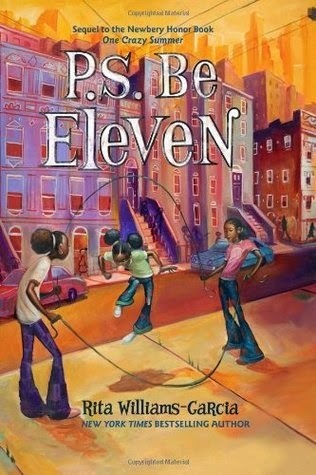
There are MANY things I love about this book, but the phrase P.S. Be Eleven woven into the story is a good reminder to us all to help kids be kids and to help parents remember that kids have big worries but we need to help them just be kids. As a lover of literature I also like this phrase as a reminder to parents to remember that their kids are just kids and there are plenty of great books out there for them to read – and not to rush into YA or Adult books that have themes not developmentally appropriate for them!
What is the funniest book you’ve read?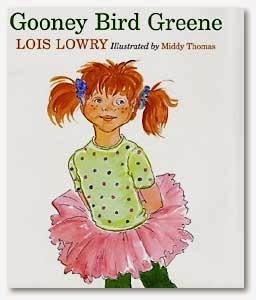
I LOVE Gooney Bird Greene (Lowry). The stories she tells makes me think and laugh all at the same time! I always hope a Gooney Bird Greene will walk in my class at the start of every school year!
What is the saddest?
This summer I read The One and Only Ivan (Applegate) on a long road trip with my husband. By the end of the book I was SOBBING! Such a powerful story that I plan to read it aloud this year to my class.
Favorite reading snack/beverage?
I love to snack on salty treats like Popcorn when I read, but have a sweet cup of hot chocolate as well!
What’s next on your TBR list?
Absolutely Almost (Graff) and The Center of Everything (Urban)
Carrie teaches grade 4 at Sidwell Friends School in Bethesda, Maryland (class twitter here) and is obsessed with traveling and reading – two hobbies that go hand in hand!
Carrie! Thank you for being such a good sport. Now, how would you fill in the following blank:
You should never read and (blank) at the same time.
You should never read and chop onions at the same time. The onion smell may mask your tears, but your fingers will be in grave danger!
If you were invited to be on Oprah, what book would you bring for her to read?
I would bring P.S. Be Eleven by Rita Williams-Garcia.

There are MANY things I love about this book, but the phrase P.S. Be Eleven woven into the story is a good reminder to us all to help kids be kids and to help parents remember that kids have big worries but we need to help them just be kids. As a lover of literature I also like this phrase as a reminder to parents to remember that their kids are just kids and there are plenty of great books out there for them to read – and not to rush into YA or Adult books that have themes not developmentally appropriate for them!
What is the funniest book you’ve read?

I LOVE Gooney Bird Greene (Lowry). The stories she tells makes me think and laugh all at the same time! I always hope a Gooney Bird Greene will walk in my class at the start of every school year!
What is the saddest?
This summer I read The One and Only Ivan (Applegate) on a long road trip with my husband. By the end of the book I was SOBBING! Such a powerful story that I plan to read it aloud this year to my class.
Favorite reading snack/beverage?
I love to snack on salty treats like Popcorn when I read, but have a sweet cup of hot chocolate as well!
What’s next on your TBR list?
Absolutely Almost (Graff) and The Center of Everything (Urban)
Published on December 02, 2014 05:30
November 26, 2014
Wednesday Wisdom
I am extraordinarily patient, provided I get my own way in the end.
Margaret Thatcher
Margaret Thatcher
Published on November 26, 2014 05:30
November 25, 2014
Teacher Tuesday
Thanks, Suzanne Gibbs for playing along with today's Teacher Tuesday! Suzanne is a fourth grade teacher who adores her kids in Spring Arbor, Michigan.
Suzanne, please fill in the blank:
You should never read and (blank) at the same time.
You should never read and drive at the same time.
If you were invited to be on Oprah, what book would you bring for her to read?
WONDER, by RJ Palacio
What is the funniest book you’ve read?
BATTLE BUNNY, by Jon Scieszka (more because it's just so darned clever!)
What is the saddest?
THE KITE RUNNER, by Khaled Hosseini
Favorite reading snack/beverage?
A glass of Malbec - and maybe (just sometimes) some Brach's Double Dippers *yum*
What’s next on your TBR list?
IDA B, by Katherine Hannigan (I probably should have read this a long time ago...)

Teachers, librarians, reading coaches, principals, custodians, lunch ladies, anyone with school connections: Please play along! Email me here and I'll get you the questions so you, too, can be featured on Teacher Tuesday.
Suzanne, please fill in the blank:
You should never read and (blank) at the same time.
You should never read and drive at the same time.
If you were invited to be on Oprah, what book would you bring for her to read?
WONDER, by RJ Palacio
What is the funniest book you’ve read?
BATTLE BUNNY, by Jon Scieszka (more because it's just so darned clever!)
What is the saddest?
THE KITE RUNNER, by Khaled Hosseini
Favorite reading snack/beverage?
A glass of Malbec - and maybe (just sometimes) some Brach's Double Dippers *yum*
What’s next on your TBR list?
IDA B, by Katherine Hannigan (I probably should have read this a long time ago...)

Teachers, librarians, reading coaches, principals, custodians, lunch ladies, anyone with school connections: Please play along! Email me here and I'll get you the questions so you, too, can be featured on Teacher Tuesday.
Published on November 25, 2014 05:30
November 21, 2014
Friend Friday
It is an honor to host Conrad Wesselhoeft on my blog today. In addition to being a fabulous writer of books for young adults, Conrad is a very kind and thoughtful person. So kind and thoughtful I know he will forgive me for the glitch that caused the delay in the posting of his essay today. Take it away, Conrad!
 Conrad Wesselhoeft
Conrad Wesselhoeft
In Praise of Place:Why fiction writers should light out for personal territory
By Conrad Wesselhoeft
In my mid-twenties, I fell in love with northeast New Mexico—the high plains, broken mesas, and rich, drifting light. I lived for two years in the town of Raton, working as a journalist for a local newspaper.
The vistas enthralled me. Much of the time, they looked flat and dull, but at certain times of day, under certain light, they exploded with beauty.
Several years ago, when I started writing my young-adult novel Dirt Bikes, Drones, and Other Ways to Fly, I wanted to re-capture that special landscape. I visualized a setting and jotted these notes:
“The country around is a hundred muted shades, washed, streaked, and bled. The nearby mesas are scarred with dirt-bike tracks, an insult to Mother Nature, but a playground for Arlo Santiago and his friends.”
Arlo is the novel’s 17-year-old adrenaline-junkie narrator. He loves to blast across the mesas on his Yamaha 250 dirt bike, hitting the bumps and flying high.
My goal was to have Arlo fit organically into this landscape. I wanted him to respond to the monotonous-one-minute, staggering-the-next horizons, just as I had.
Whether I pulled it off is not for me to say. What I did learn, however, is how important setting can be to a story—so important, in fact, that it can become a galvanizing character in its own right.
Too often, writers overlook setting in favor other characterization tools. The result is that New York City appears no different in the mind’s eye than Portland, Oregon, and the Grand Canyon exudes all the gravitas of a touched-up postcard.
It’s as if the writer had stuck a pin on a map and said, “I think I’ll set my story here.”
But when setting works—when a writer dips into his or her own life and bares emotions connected with a place—the results can be glorious.
Scott O’Dell’s love for California’s coastal islands shimmers on every page of Island of the Blue Dolphins. You more than hear the gulls cry, waves crash, and wind blow. The island on which the narrator Karana lives seems alive.
Lois Lowry drew on ambivalent memories of growing up on military bases to create the stark, regimented world of her 1993 dystopian novel The Giver.
C.S. Lewis based his sweeping Narnia vistas on the Mountains of Mourne in Northern Ireland. About them, he wrote: "I have seen landscapes . . . which, under a particular light, make me feel that at any moment a giant might raise his head over the next ridge.”
In every case the writer traversed a personal geography to inform a fictional one. His or her emotional connection to a real place grounded the reader in an imagined place.
When a writer soaks up the spirit of a town, city, island, mesa—or just about anywhere else—that place can inspire a profound fictional setting.
A great story puts you there, so that you see and feel the landscape around you. Writers get there by digging into their personal geography and listening for the heartbeat.
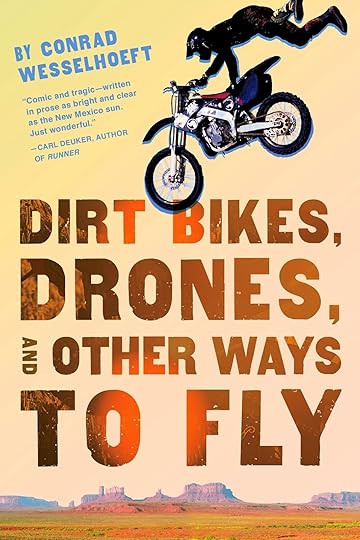
 Conrad Wesselhoeft
Conrad WesselhoeftIn Praise of Place:Why fiction writers should light out for personal territory
By Conrad Wesselhoeft
In my mid-twenties, I fell in love with northeast New Mexico—the high plains, broken mesas, and rich, drifting light. I lived for two years in the town of Raton, working as a journalist for a local newspaper.
The vistas enthralled me. Much of the time, they looked flat and dull, but at certain times of day, under certain light, they exploded with beauty.
Several years ago, when I started writing my young-adult novel Dirt Bikes, Drones, and Other Ways to Fly, I wanted to re-capture that special landscape. I visualized a setting and jotted these notes:
“The country around is a hundred muted shades, washed, streaked, and bled. The nearby mesas are scarred with dirt-bike tracks, an insult to Mother Nature, but a playground for Arlo Santiago and his friends.”
Arlo is the novel’s 17-year-old adrenaline-junkie narrator. He loves to blast across the mesas on his Yamaha 250 dirt bike, hitting the bumps and flying high.
My goal was to have Arlo fit organically into this landscape. I wanted him to respond to the monotonous-one-minute, staggering-the-next horizons, just as I had.
Whether I pulled it off is not for me to say. What I did learn, however, is how important setting can be to a story—so important, in fact, that it can become a galvanizing character in its own right.
Too often, writers overlook setting in favor other characterization tools. The result is that New York City appears no different in the mind’s eye than Portland, Oregon, and the Grand Canyon exudes all the gravitas of a touched-up postcard.
It’s as if the writer had stuck a pin on a map and said, “I think I’ll set my story here.”
But when setting works—when a writer dips into his or her own life and bares emotions connected with a place—the results can be glorious.
Scott O’Dell’s love for California’s coastal islands shimmers on every page of Island of the Blue Dolphins. You more than hear the gulls cry, waves crash, and wind blow. The island on which the narrator Karana lives seems alive.
Lois Lowry drew on ambivalent memories of growing up on military bases to create the stark, regimented world of her 1993 dystopian novel The Giver.
C.S. Lewis based his sweeping Narnia vistas on the Mountains of Mourne in Northern Ireland. About them, he wrote: "I have seen landscapes . . . which, under a particular light, make me feel that at any moment a giant might raise his head over the next ridge.”
In every case the writer traversed a personal geography to inform a fictional one. His or her emotional connection to a real place grounded the reader in an imagined place.
When a writer soaks up the spirit of a town, city, island, mesa—or just about anywhere else—that place can inspire a profound fictional setting.
A great story puts you there, so that you see and feel the landscape around you. Writers get there by digging into their personal geography and listening for the heartbeat.

Published on November 21, 2014 16:13
November 19, 2014
Wednesday Wisdom
No song or poem will bear my mother's name, yet so many of the stories that I write, that we all write, are my mother's stories.
Alice Walker
Alice Walker
Published on November 19, 2014 05:30
November 18, 2014
Teacher Tuesday
Good sport Eve Eaton is a first grade teacher at Sidwell Friends School in Washington, DC where she enjoys learning and laughing with her students and co-teacher every day.
Eve, please fill in the blank: You should never read and (blank) at the same time.
You should never read and walk at the same time. It can lead to accidents!
If you were invited to be on Oprah, what book would you bring for her to read?
I think I would bring The One and Only Ivan by Katherine Applegate. In the words of some young people in my life - It's such an emotional book. Ivan has a tough life, yet he is still able to find joy and hope. Kids can relate to many topics in the book and connect easily with Ivan. It's the kind of book you can read again and again.
What is the funniest book you’ve read?
When I think of funny books for older kids, The Phantom Tollbooth by Norton Juster immediately comes to mind. The word play is so much fun, and this book makes a great class play! Of course, the funniest book series for younger kids is the Mercy Watson series (no surprise there!). Mercy seems to get into troublesome situations without meaning to, and then somehow everything works out well in the end.
What is the saddest?
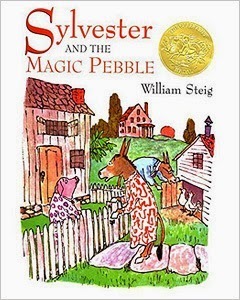
This was a tough question. I have always thought that Sylvester and the Magic Pebble by William Steig is such a sad book. Even as a kid, I would get frustrated when Sylvester's family was nearby and he couldn't talk to them! The Giving Tree by Shel Silverstein was also so sad to me when I was a child because the little boy doesn't appreciate the gift of friendship for such a long time. For older readers, I think Bridge to Terabithia by Katherine Paterson is one of the saddest books. I feel that it was the first book I read as a kid where there wasn't a happy ending. It made me keep thinking about the story and reading it several times.
Favorite reading snack/beverage?
I love to read, eat popcorn and drink orange juice. Not too messy and very satisfying.
What’s next on your TBR list?
I am really looking forward to reading Fiona's Lace by Patricia Polacco and Leroy Ninker Saddles Up by Kate DiCamillo.
Teachers, librarians, reading coaches, principals, custodians, lunch ladies, anyone with school connections: Please play along! Email me here and I'll get you the questions so you, too, can be featured on Teacher Tuesday.
Eve, please fill in the blank: You should never read and (blank) at the same time.
You should never read and walk at the same time. It can lead to accidents!
If you were invited to be on Oprah, what book would you bring for her to read?
I think I would bring The One and Only Ivan by Katherine Applegate. In the words of some young people in my life - It's such an emotional book. Ivan has a tough life, yet he is still able to find joy and hope. Kids can relate to many topics in the book and connect easily with Ivan. It's the kind of book you can read again and again.
What is the funniest book you’ve read?
When I think of funny books for older kids, The Phantom Tollbooth by Norton Juster immediately comes to mind. The word play is so much fun, and this book makes a great class play! Of course, the funniest book series for younger kids is the Mercy Watson series (no surprise there!). Mercy seems to get into troublesome situations without meaning to, and then somehow everything works out well in the end.
What is the saddest?

This was a tough question. I have always thought that Sylvester and the Magic Pebble by William Steig is such a sad book. Even as a kid, I would get frustrated when Sylvester's family was nearby and he couldn't talk to them! The Giving Tree by Shel Silverstein was also so sad to me when I was a child because the little boy doesn't appreciate the gift of friendship for such a long time. For older readers, I think Bridge to Terabithia by Katherine Paterson is one of the saddest books. I feel that it was the first book I read as a kid where there wasn't a happy ending. It made me keep thinking about the story and reading it several times.
Favorite reading snack/beverage?
I love to read, eat popcorn and drink orange juice. Not too messy and very satisfying.
What’s next on your TBR list?
I am really looking forward to reading Fiona's Lace by Patricia Polacco and Leroy Ninker Saddles Up by Kate DiCamillo.
Teachers, librarians, reading coaches, principals, custodians, lunch ladies, anyone with school connections: Please play along! Email me here and I'll get you the questions so you, too, can be featured on Teacher Tuesday.
Published on November 18, 2014 05:30



